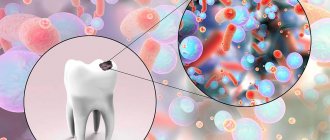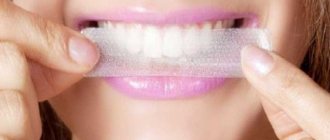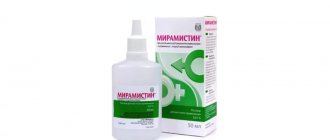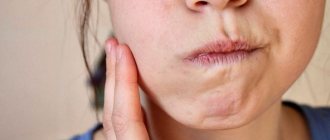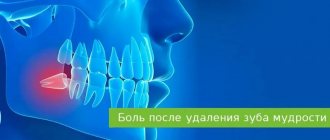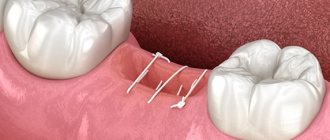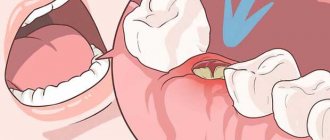A high-quality and rapid wound healing process after tooth extraction depends not only on the professionalism of the doctor who performed the extraction (removal) of the tooth, but on the correct behavior of the patient after the procedure, who must strictly follow the recommendations given by the doctor for the period of healing of the wound surface. If you correctly and clearly follow the advice of a specialist, the recovery process occurs quickly and as painlessly as possible.
For example, patients who do not listen to the recommendations given to them make rinsing movements in the area of the healing wound; this washes out the blood clot, which performs a protective function against the entry of bacteria and microbes, as a result of which there is a high risk of wound suppuration.
In this article we want to give recommendations on what should and can be done after tooth extraction, and what should not be done.
1. A gauze swab on the hole. When can it be taken out?
As a rule, the doctor does not immediately release the patient after removal, but asks him to wait for 15-20 minutes within the clinic to then examine and make sure that everything is in order with blood clotting and the tampon can be removed without fear. In rare cases, keeping the tampon in your mouth may take 30-40 minutes, usually 10-20 minutes. There is no need to keep it longer and it is even dangerous, because bacteria accumulate on it and there is a possibility of infection. There are exceptions, when the wound continues to bleed a little, then the old tampon is replaced with a new sterile one and kept for some time.
For some time, saliva may still be pinkish due to staining with secreted ichor, this should not be alarming, this situation can be distinguished from bleeding. At this moment, saliva can be easily swallowed; there is no need to accumulate it in the mouth.
2. After what time can you eat and drink?
After removal, you can drink water. After two hours you can eat. The limiting condition is not to chew rough food on the side of the extracted tooth in the first few days. Hard food can damage the blood clot, which is located in the socket and is needed for wound healing. If the patient experiences an acute feeling of hunger, then no one forbids eating cool yogurt or kefir. In the first days of healing of the hole, it is better to completely avoid eating rough, hard, solid foods, so as not to make strong chewing movements, as well as spicy, salty foods, so as not to irritate the oral mucosa. It is also important to monitor the temperature of food and drinks; they should not be too hot.
What do we have to do
After the removal procedure, you need to limit your activity for a while, adhere to a healthy lifestyle and diet.
It is better to take the so-called “sick leave” - spend time at home in a calm environment, closely monitoring your condition.
Smoking and drinking alcoholic beverages are prohibited; it is better to abstain from them.
The menu for the recovery period should consist of nutritious food that does not require thorough chewing. It is better to reduce the number of meals by increasing the calorie content of dishes.
It is imperative to carry out hygienic procedures, since ignoring them can trigger an inflammatory process in the socket of an extracted tooth.
Mouth rinsing is prohibited; it is better to replace it with medicinal baths.
You need to make sure that the postoperative sutures do not come apart; to do this, you should not open your mouth wide or strain your facial muscles.
3.Applying ice.
After tooth extraction in our Center, a specialist will give you ice specially prepared for such procedures to apply in the first hours after extraction. Ice is applied for a certain time, at certain intervals, which the doctor will instruct you about. At home, this procedure will need to be continued for some time (the first few hours after removal). This is done in order to minimize or completely eliminate tissue swelling.
Under no circumstances should you heat the area in the area of the extracted tooth; in this case, suppuration will develop.
6. Medications after removal.
After the procedure, the doctor prescribes a number of medications to take. Under no circumstances should you take any medications on your own, without consulting a doctor.
Painkillers should be taken in case of pain, at intervals and in the amount recommended by the doctor. Each case is individual; it happens that the patient does without taking painkillers.
Antibiotics. In some cases, after removal, antibiotics are prescribed for 5-7 days. As a rule, these are situations when the doctor removes a tooth in the stage of inflammation, complex extraction or removal of several units of teeth. Only a specialist surgeon decides whether to take antibiotics or not.
Antihistamines. Reduces the likelihood of swelling.
Antiseptics. Used as a rinse. BUT, remembering that rinsing movements are prohibited in the first days. A small amount of solution is taken into the mouth and simply held in the mouth, then calmly spit out. Such baths must be done if the tooth was removed during the inflammation phase, if the flux was exposed, if there are teeth affected by caries in the oral cavity.
7.High blood pressure.
In patients with high blood pressure, there is a risk that the wound may bleed longer than usual. In this case, you need to regulate the pressure by taking appropriate medications to reduce it. In our SDent dental medical center, even before the start of manipulations, the doctor always finds out the main points about the general health of the patient. If the patient has hypertension, the specialist knows about this problem in advance and then gives the necessary recommendations appropriate to the case.
A rehabilitologist told how to recover from COVID-19
Leonid Dyakov, a specialist at the Department of Medical Rehabilitation, Sports Medicine and Exercise Therapy at the Rostov State Medical University, a member of the European Association of Outpatient Rehabilitation Physicians, answered RG’s questions.
— When can a person be considered fully recovered?
Leonid Dyakov: After all the symptoms disappeared, normal test results were obtained. And when a person feels that he can return to normal life, fulfill his duties, and nothing limits him: there is no shortness of breath, no palpitations, or other suspicious phenomena.
If something bothers you after being discharged from the hospital or leaving sick leave, you need to consult a doctor. Everyone suffers in their own way. The health consequences can be different, so everyone should have their own set of examinations.
— What tests need to be taken, which organs should be checked?
Leonid Dyakov: It would be good to do a CT scan of the lungs within a year after discharge. There is no need to be afraid of radiation doses - modern devices are practically harmless. Only with computed tomography can complications be detected. It will help identify areas of the lungs that are affected. And then compensation mechanisms can be launched in a timely manner. But it’s still better for the doctor to decide this in the specific situation that the patient has. If nothing bothers you, there is no pain, there is no shortness of breath, there is no point in doing any research.
Also, after discharge, I advise you to do an ECG and urine test, a general blood test with detection of the leukocyte formula, and determination of the relative and absolute number of lymphocytes within a year. Conduct an examination for glycoproteins, which are produced in the liver and indicate the degree of inflammation or tissue necrosis. And also - examine blood serum for changes in the concentration of immunoglobulins. They allow you to establish the general immune status of the body and determine what treatment is necessary.
An important indicator of the functioning of the respiratory system - the function of external respiration - can be studied using spirometry. This is a simple manipulation, it is performed by a pulmonologist. And in home practice, you can use a portable pulse oximeter. A miniature device will determine the oxygen saturation of the blood. This indicator should also be monitored throughout the year; it should become a habit, like measuring blood pressure with a tonometer.
— What to do if test results are abnormal?
Leonid Dyakov: In case of deviations from the norm - in tests, CT scans, ultrasound - it is better to discuss this with a specialist. Some deviations are acceptable. It is better to recover under the supervision of a therapist.
— People who have been seriously ill with COVID-19 talk about damage to part of the lung, sometimes up to 40 percent. Can the organ be restored and what needs to be done for this?
Leonid Dyakov: In fact, the lung tissue is well compensated. Even the alveoli are restored. Nature has insured a person in this case; it is not for nothing that the lungs are a paired organ, and a person can live without problems with one lung. Of course, everything is very individual and depends on many factors. The lower the percentage of damage, the better and faster the process goes.
But unfortunately, the lungs are not the only organ that suffers from the virus. One of the most common complications of Covid is myocarditis, inflammation of the heart muscle. It is especially dangerous because it may not develop immediately, but after a while. The virus attacks the endothelium, the inner “lining” of blood vessels, and the vessels run throughout the body. One of the most vulnerable places is the myocardium. For the same reason, the kidneys may suffer. After all, they are a tangle of blood vessels. If the virus affects them, then problems are inevitable.
— How long can the recovery period last?
Leonid Dyakov: Rehabilitation will take quite a long period, especially if you had to resort to mechanical ventilation. The old Soviet recovery system allowed three months for the treatment of ordinary pneumonia, and this period necessarily included sanatorium treatment.
This was an extremely important stage. Previously, even before the revolution, patients went “to the water” and breathe the air. In some places, balneological technologies and climatic therapy are still preserved. Dry sea, pine air is healing. This is Crimea, Gelendzhik.
Usually, after seasonal acute respiratory viral infections, the body recovers in one to two weeks, depending on the severity of the disease. Recovery from coronavirus infection takes on average from one to 2.5 months. The complications that arise and the general deterioration in well-being after COVID-19 are called post-Covid syndrome.
— They say coronavirus is a call to reconsider your life. What needs to change in life?
Leonid Dyakov: Of course, any illness is a reason to stop, look around, and analyze your life. An inactive lifestyle, bad habits and an incorrect psychological attitude lead to illness - this is no secret to anyone.
— How to eat properly after an illness? Do I need to take vitamins, which ones and for how long?
Leonid Dyakov: Three or four times a day would be good. And that the menu includes fresh fruits and vegetables. At least a couple of times a week protein - fish, meat dishes. In severe cases of the disease, a significant loss of protein proteins occurs in the body. Very important during the recovery period are the fats that make up the surfactant, a substance that prevents the pulmonary alveoli from sticking together. These should be fats of natural origin (not palm oil) - butter, sunflower, olive oil.
And, of course, vitamins. A person receives large doses already during the course of treatment. But even after discharge, it is advisable to take multivitamins with microelements for three months after clinical recovery.
— Vitamins are the same as for illness: vitamin C in a horse dose of 1000 mg? Vitamin D?
Leonid Dyakov: No, rather prophylactic doses in ready-made pills. There are some good complexes. All this should be discussed with a doctor who knows the patient.
— Is it necessary to seek a course in a rehabilitation program or is it better to go to the forest, to the dacha or to the Mineral Waters and just take a walk there?
Leonid Dyakov: With our high pace of life and stress, a couple of times a year you need to get away from your usual life, leave the city to breathe fresh air by the river, in the forest, in the mountains or by the sea.
Most survivors do not need a rehabilitation program. Only if there are severe complications. This is discussed with the attending physician, a therapist at the clinic, who will help arrange sanatorium-resort treatment.
— What exercises will help those recovering?
Leonid Dyakov: Exercises are also selected individually. A universal exercise that I recommend is walking.
If you didn’t walk before you got sick, and then suddenly started, you need to monitor your pulse and exercise.
It is unusual for city dwellers to walk a lot, but for recovery it is necessary. Relatives can join you and organize a two- to three-hour walk for therapeutic purposes. You need to approach this strictly individually; for some it’s just slow walking. Swimming has a good rehabilitative effect: here, in addition to the benefits of breathing exercises, the muscles that support the lungs are also included in the recovery process. But swimming should be swimming, not getting wet in a pool.
— How to restore psycho-emotional balance?
Leonid Dyakov: The most painful topic is psycho-emotional balance. Every patient who has been in a hospital needs help. Some had relatives who were seriously ill, others saw people nearby dying in Covid hospitals - the patient experienced enormous stress. The help of a psychologist may be needed to determine whether the patient needs more serious help. For example, our center deals not only with physical, but also with psychological rehabilitation.
— What can’t be done after coronavirus?
Leonid Dyakov: Drink alcohol, smoke, take on excessive physical activity. This not only prevents the strengthening of the immune system, but also leads to a worsening of the condition. You cannot overcool, neglect proper nutrition, or lack sleep.
Strengthened cardio exercises are contraindicated. And you cannot refuse rehabilitation in case of severe consequences of the disease, accompanied by shortness of breath.
8.What happens to the sutures after removal.
After the tooth is removed, the surgeon places sutures on the wound surface. This promotes faster healing, reduced pain, less risk of inflammation, minimizes the risk of bleeding, and protects the blood clot from falling out.
At the SDent clinic we use the most modern and safe materials. The thread with which the surgeon sews the edges of the hole is self-absorbing. But during the process, the ends of the thread can cause discomfort to the patient and interfere with the oral cavity. Therefore, for the comfort and safety of the patient, the doctor always sets an appointment date for examination and removal of sutures in approximately 10 days.
The first two hours after extraction
Removal of a tooth
After the doctor removes the tooth from the bone alveolus, the patient will undergo antiseptic treatment of the hole with bactericidal and antimicrobial drugs. A turunda soaked in a medicine with a hemostatic effect is placed in the hole, which is an open wound surface. These medications help stop bleeding caused by damaged blood vessels and prevent excessive blood loss.
The doctor puts medicine into the hole
The gauze turunda must be kept in the mouth for 15-30 minutes - the exact time depends on the medicine used. During this time, it is better to stay at the office of the doctor who performed the extraction. This is especially important for people with heart or respiratory conditions (such as asthmatics), as drugs used for local anesthesia, combined with post-operative bleeding, can cause serious side effects, such as increased heart rate, shortness of breath, dizziness . The most dangerous consequence is considered to be angioedema, a severe form of allergy that occurs primarily to medications used for local anesthesia.
Gauze swab in the hole
Within two hours after surgery you cannot:
- rinse your mouth;
- consume food and drinks;
- warm the sore spot;
- take medications from the analgesic group (so as not to cause an overdose of potent substances).
To reduce the intensity of pain, reduce swelling, stop bleeding and prevent inflammation, you can use cold compresses. To do this, you need to wrap several ice cubes in a piece of thick fabric, folded in several layers (you can use a terry towel), and apply it to the sore spot. You need to hold it for no more than 1.5-2 minutes, after which you need to take a break for 10-15 minutes. In total, you can repeat the procedure up to five times. If you do this more often, or keep the cold for several minutes in a row, you can chill the soft gum tissue at the site of tooth extraction and cause a purulent-inflammatory process.
- How soon can you eat after tooth extraction?
A cold compress will help temporarily relieve your suffering.
Important! Within 30 minutes after the tooth is removed from the bone alveolus, the hole is filled with blood, which coagulates and forms a blood clot that protects the wound from infection and food debris. Under no circumstances should you constantly touch the clot with your tongue, press on it and try to push it out of the hole. This can cause the formation of a “dry socket” and alveolitis, in which the patient will have to seek the help of a dentist again and re-injure the gums.
Alveolitis of the hole after tooth extraction
After tooth extraction, you should not do the following.
- In the first couple of days, taking a hot bath is excluded, only a warm shower.
- During sleep, you need to be careful not to lie on the side where the tooth was removed, this provokes the appearance of swelling.
- Visiting the gym and active physical activity should be postponed in the first days.
- Do not touch the wound with your tongue or foreign object.
- Do not open your mouth very wide, do not use active chewing and facial movements to avoid the sutures coming apart.
- Aspirin is not suitable as an anesthetic due to the fact that it has a thinning effect on the blood and may cause bleeding and hematoma.
- Do not rinse during the first few days. This can negatively affect the loss of a blood clot from the socket and the occurrence of inflammation.
For more information and to make an appointment with a specialist, call:
+7,
About the medicine
The medicine that is placed in the hole can be applied to a piece of gauze, which is subsequently inserted into the hole. In this case, after a certain amount of time indicated by the doctor, it needs to be taken out. This can be done either independently or during your next visit to the dentist. If this is not done in time, the process of putrefaction may begin, which will greatly complicate the situation. It is also not recommended to take out the gauze ahead of time, since food particles can get into the hole and the tongue can touch it, which will interrupt the healing process and also cause complications.
A hemostatic sponge with medication can be installed in the hole.
There is another way to install the medicine - in a hemostatic sponge. It already contains a medicine that helps disinfect the socket cavity and helps stop bleeding. You cannot take this sponge out - it will dissolve on its own. Most often this happens within 1-2 days, but in some cases the sponge may remain in the hole for 5-6 days. There is no need to be afraid of this. As a last resort, you can consult a doctor who will examine the wound and determine whether healing is proceeding normally.
Often the medicine in the sponge is very bitter, and this causes severe discomfort to the person. Unfortunately, nothing can be done about this, since getting rid of the sponge ahead of time is strictly contraindicated. To eliminate bitterness, you can drink sweet tea or juice.
- Why do my gums hurt after tooth extraction?
Remember ! No circumstances can influence the ability to remove the medicine from the hole ahead of time. After 3-4 days, the surface of the hole will heal, and you will no longer have to experience discomfort.
You cannot take out gauze or sponge with medicine on your own - this can cause complications.
People often wonder what kind of medicine is used for these purposes. Sometimes the gauze that is placed in the hole is treated with iodine - this will both disinfect the wound and prevent bleeding. The hemostatic sponge is already treated with a special substance consisting of boric acid, collagen and nitrofural, which helps stop the bleeding and protect the hole from various influences. But most often dentists use Alvozhil.
"Alvogil"
No other means are used for inserting into the hole.

